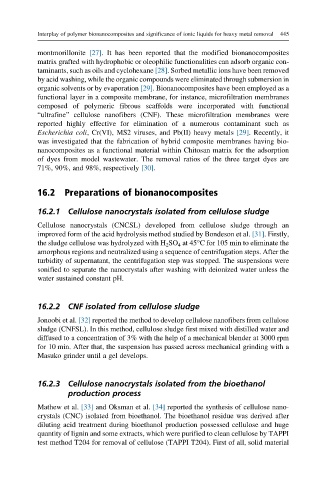Page 492 - Polymer-based Nanocomposites for Energy and Environmental Applications
P. 492
Interplay of polymer bionanocomposites and significance of ionic liquids for heavy metal removal 445
montmorillonite [27]. It has been reported that the modified bionanocomposites
matrix grafted with hydrophobic or oleophilic functionalities can adsorb organic con-
taminants, such as oils and cyclohexane [28]. Sorbed metallic ions have been removed
by acid washing, while the organic compounds were eliminated through submersion in
organic solvents or by evaporation [29]. Bionanocomposites have been employed as a
functional layer in a composite membrane, for instance, microfiltration membranes
composed of polymeric fibrous scaffolds were incorporated with functional
“ultrafine” cellulose nanofibers (CNF). These microfiltration membranes were
reported highly effective for elimination of a numerous contaminant such as
Escherichia coli, Cr(VI), MS2 viruses, and Pb(II) heavy metals [29]. Recently, it
was investigated that the fabrication of hybrid composite membranes having bio-
nanocomposites as a functional material within Chitosan matrix for the adsorption
of dyes from model wastewater. The removal ratios of the three target dyes are
71%, 90%, and 98%, respectively [30].
16.2 Preparations of bionanocomposites
16.2.1 Cellulose nanocrystals isolated from cellulose sludge
Cellulose nanocrystals (CNCSL) developed from cellulose sludge through an
improved form of the acid hydrolysis method studied by Bondeson et al. [31]. Firstly,
the sludge cellulose was hydrolyzed with H 2 SO 4 at 45°C for 105 min to eliminate the
amorphous regions and neutralized using a sequence of centrifugation steps. After the
turbidity of supernatant, the centrifugation step was stopped. The suspensions were
sonified to separate the nanocrystals after washing with deionized water unless the
water sustained constant pH.
16.2.2 CNF isolated from cellulose sludge
Jonoobi et al. [32] reported the method to develop cellulose nanofibers from cellulose
sludge (CNFSL). In this method, cellulose sludge first mixed with distilled water and
diffused to a concentration of 3% with the help of a mechanical blender at 3000 rpm
for 10 min. After that, the suspension has passed across mechanical grinding with a
Masuko grinder until a gel develops.
16.2.3 Cellulose nanocrystals isolated from the bioethanol
production process
Mathew et al. [33] and Oksman et al. [34] reported the synthesis of cellulose nano-
crystals (CNC) isolated from bioethanol. The bioethanol residue was derived after
diluting acid treatment during bioethanol production possessed cellulose and huge
quantity of lignin and some extracts, which were purified to clean cellulose by TAPPI
test method T204 for removal of cellulose (TAPPI T204). First of all, solid material

